
A shotel is a curved sword originating in Eritrea and northern Ethiopia. The curve on the blade varies from the Persian shamshir, adopting an almost semicircular shape. The blade is flat and double-edged with a diamond cross-section. The blade is about 40 inches (1 m) in total length and the hilt is a simple wooden or rhinoceros horn piece with no guard similar to the jile or jambiya. The shotel was carried in a close fitting leather scabbard which was often decorated in precious metals and worn on the right side.
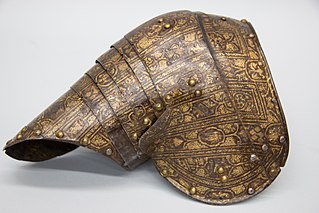
A rerebrace is a piece of armour designed to protect the upper arms. Splint rerebraces were a feature of Byzantine armour in the Early Medieval period. The rerebrace seems to have re-emerged in England, in the early 14th century. As part of the full plate armour of the Late Middle Ages and Renaissance the rerebrace was a tubular piece of armour between the shoulder defences and the elbow protection (couter).
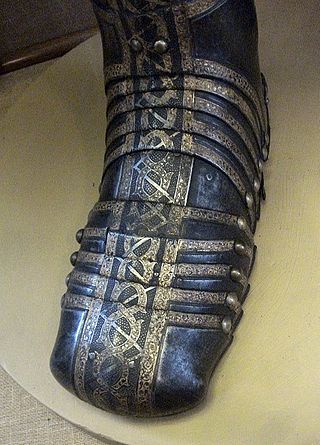
A lame is a solid piece of sheet metal used as a component of a larger section of plate armor used in Europe during the medieval period. It is used in armors to provide articulations or the joining of the armor elements. The size is usually small with a narrow and rectangular shape. Multiple lames are riveted together or connected by leather straps or cloth lacing to form an articulated piece of armor that provides flexible protection. The armor worn by the samurai class of feudal Japan used lames in the construction of many of their individual armor parts. The Japanese term is ita, which can both refer to the lame or its borderings.

The yoroi-dōshi (鎧通し), "armor piercer" or "mail piercer", is one of the traditionally made Japanese swords that were worn by the samurai class as a weapon in feudal Japan.
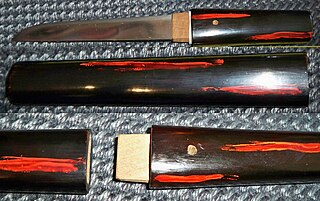
A kaiken is a 20–25 cm (7.9–9.8 in) long, single or double-edged Japanese knife usually without ornamental fittings housed in a plain but lacquered mount.
George Cameron Stone was a well-known American arms collector and author as well as an American mining engineer and metallurgist. He authored a glossary of the antique weapons of the world that remains one of the most comprehensive works ever written on the subject.
Moplah sword is a sword used by the Muslim population in the Malabar Coast in southwestern India. The Moplah sword has been used since the 17th Century, both as a weapon and a tool.

Kusari katabira is the Japanese term for mail armour. Kusari is a type of armour used by the samurai class and their retainers in feudal Japan. When the word kusari is used in conjunction with an armoured item, it usually means that the kusari makes up the majority of the armour defence.

Niabor is a curved sword from Borneo, a characteristic weapon of the Sea-Dayaks.

The Pandat is the war sword of the Dayak people of northwest Borneo and is never used as a tool. On October 18, 2016, this weapon was featured in season 3 episode 9 of the American bladesmithing competition series Forged in Fire.

Parang Nabur is a sword that originates from Banjarmasin, South Kalimantan, Indonesia. Most of these swords were made during the Banjarmasin Sultanate period in the 19th century.
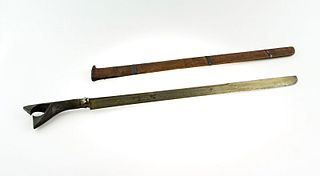
Sikin Panjang is a sword originated from northern Sumatra, Indonesia.

Palitai is the traditional knife of the Mentawai people, originating from the Mentawai Islands off West Sumatra, Indonesia.

Wedung is a traditional large knife of the Javanese people and the Balinese people originating from Indonesia.

Kurabit is a traditional shield originating from the Mentawai Islands off the coast of West Sumatra, Indonesia.

A Piso Halasan is a traditional sword of the Batak people from North Tapanuli Regency, North Sumatra, Indonesia.

Alamang or Sonri is a sacred sword or cutlass of the Bugis and Makassarese people in Sulawesi, Indonesia.
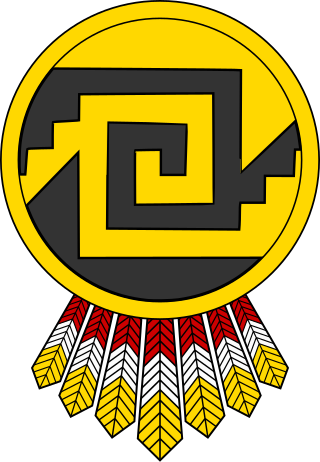
The Chīmalli or Aztec shield was the traditional defensive armament of the indigenous states of Mesoamerica. These shields varied in design and purpose. The Chīmalli was also used while wearing special headgear.
The Jamdhar-Katari is the traditional dagger of the Hindu Kush strains in Afghanistan.

Katapu or Kalapu is a traditional war cap or helmet used by the Dayaks of Borneo. The katapu is only worn during war.
This page is based on this
Wikipedia article Text is available under the
CC BY-SA 4.0 license; additional terms may apply.
Images, videos and audio are available under their respective licenses.

















